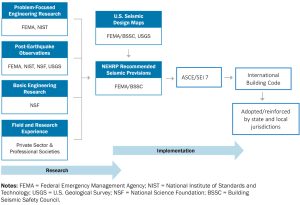Seismic Code and Standard Development and NEHRP Recommended Provisions
Major earthquakes are rare compared to other natural hazards such as wind, floods, and snowstorms; however, the destructive power of major earthquakes can be devastating. Thousands of lives and billions of dollars in economic investment could be lost in poorly prepared communities. Our nation’s seismic risk can be largely reduced through earthquake-resistant buildings designed and constructed in compliance with modern building codes.
Protecting the Built Environment
In dealing with earthquakes, it is essential to understand that the risk of building failure or collapse is real and more significant than many other natural hazard impacts. Buildings are designed to survive damage and be robust enough to provide sufficient stability to minimize the risk of collapse. However, designing structures resistant to major earthquakes is a complex process, and developing seismic design provisions and codes applicable across the nation is even more daunting.
Seismic requirements in the building codes can be traced back to the 1927 Uniform Building Code (UBC) with non-mandatory provisions. Since then, seismic design has evolved significantly with many milestones like (not limited to) the development of the Recommended Lateral Force Requirements and Commentary (the Blue Book) in 1959 and subsequent updates by the Structural Engineers Association of California (SEAOC) and the publication of the landmark ATC 3-06 report, Tentative Provisions for the Development of Seismic Regulations for Buildings by the Applied Technology Council (ATC) in 1978. In addition, the establishment of the National Earthquake Hazards Reduction Program (NEHRP) (Public Law 95-124) in 1977, and subsequent reauthorizations (latest reauthorization in 2018 Public Law 115-307), provided significant support for the development of nationally applicable seismic regulations and modern building codes and standards.
The NEHRP Recommended Seismic Provisions for New Buildings and Other Structures (Recommended Provisions), developed by the Building Seismic Safety Council (BSSC), supported and published by the Federal Emergency Management Agency (FEMA) on behalf of NEHRP, provides a consensus-based code resource for improving nationally applicable standards and model building codes. Since its inception, the Recommended Provisions have evolved from a code language document adopted by the regional model building codes and the first two editions of the International Building Code (IBC) to a code resource document that feeds into the ASCE/SEI 7 Minimum Design Loads and Associated Criteria for Buildings and Other Structures and then the IBC. The Recommended Provisions result from a successful collaboration with public and private sectors for translation of research results for best practices and implementation in codes and standards. The NEHRP Provisions Update Committee (PUC) involves leading practicing engineers, code and standard specialists, university researchers, construction material industry professionals, and NEHRP agency representatives. Through the two-tiered BSSC consensus process, the PUC and BSSC member/professional organizations evaluate and resolve all proposed technical changes to be included in the Recommended Provisions. The NEHRP Recommended Provisions have become a well-known brand in the United States and internationally.
Topics Considered
The Recommended Provisions are regularly updated in a three- to six-year cycle, and each update engages over 100 top experts and around 40 relevant organizations in the field of earthquake engineering. FEMA’s resource support and close association with USGS and NIST have led to significant technical changes. These include updated U.S. seismic design maps (by USGS), new seismic force-resisting systems, qualification of design coefficients and response modification factors, integration of occupancy with seismic mapping and seismic design categories, design requirements for structural irregularities and deflection (drift), improved design force formula for nonstructural components, and more.
Besides developing important code changes, Recommended Provisions introduce innovative concepts and new procedures for trial use by the design community, researchers, and standard- and code-development organizations (often called NEHRP resource papers). Supporting and educational documents are also produced to provide design examples to walk practicing engineers, code officials, students, and other stakeholders through the Recommended Provisions and corresponding standards and codes.
Current Edition
The 2020 NEHRP Recommended Provisions (FEMA P-2082) mark the tenth edition of this technical resource document since its first publication in 1985. Most of the recommended code changes in Part 1 of the document are adopted by ASCE/SEI 7-22, which will be adopted by reference by the 2024 IBC.
The 2020 NEHRP Recommended Provisions: Design Examples (FEMA P-2192) were developed by BSSC for FEMA to illustrate and explain the major changes of the 2020 NEHRP Recommended Provisions, ASCE/SEI 7-22, and the material design standards referenced therein in design applications. The Design Examples were developed primarily for design practitioners. However, college students learning about earthquake engineering and engineers studying for their licensing exam or designing in regions of moderate and high seismicity will find this document’s explanation of earthquake engineering, the 2020 NEHRP Recommended Provisions, and ASCE/SEI 7-22 seismic provisions helpful.
A National Institute of Building Sciences webinar series (https://bit.ly/3yypsmD), organized following the eight chapters in the Design Examples, was conducted in the first half of 2022 and serves as part of the FEMA NEHRP/BSSC outreach and education effort. A series of technical articles based on the webinar series will appear in future issues of STRUCTURE.
Moving Forward
One may consider that seismic design is one of the complicated fields in engineering design. The process by which the seismic design requirements are developed to take form in the building code has been a very successful model and will continue to support seismic design advancement and innovation. It could also provide insight into other hazards, such as how wind or flood can be consistently treated, how the building industry supports community resilience and adapts to climate change, and how federal agencies and the private sector can collaborate.
Acknowledgment
Steven McCabe from the National Institute of Standard and Technology provided a peer review of the article.■

